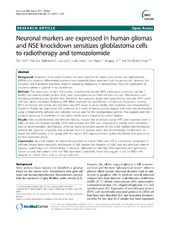| dc.description.abstract | Background: Expression of neuronal elements has been identified in various glial tumors, and glioblastomas (GBMs) with neuronal differentiation patterns have reportedly been associated with longer survival. However, the neuronal class III b-tubulin has been linked to increasing malignancy in astrocytomas. Thus, the significance of neuronal markers in gliomas is not established. Methods: The expressions of class III b-tubulin, neurofilament protein (NFP), microtubule-associated protein 2 (MAP2) and neuron-specific enolase (NSE) were investigated in five GBM cell lines and two GBM biopsies with immunocytochemistry and Western blot. Moreover, the expression levels were quantified by real-time qPCR under different culture conditions. Following NSE siRNA treatment we used Electric cell-substrate impedance sensing (ECIS) to monitor cell growth and migration and MTS assays to study viability after irradiation and temozolomide treatment. Finally, we quantitated NSE expression in a series of human glioma biopsies with immunohistochemistry using a morphometry software, and collected survival data for the corresponding patients. The biopsies were then grouped according to expression in two halves which were compared by survival analysis. Results: Immunocytochemistry and Western blotting showed that all markers except NFP were expressed both in GBM cell lines and biopsies. Notably, qPCR demonstrated that NSE was upregulated in cellular stress conditions, such as serum-starvation and hypoxia, while we found no uniform pattern for the other markers. NSE knockdown reduced the migration of glioma cells, sensitized them to hypoxia, radio- and chemotherapy. Furthermore, we found that GBM patients in the group with the highest NSE expression lived significantly shorter than patients in the low-expression group. Conclusions: Neuronal markers are aberrantly expressed in human GBMs, and NSE is consistently upregulated in different cellular stress conditions. Knockdown of NSE reduces the migration of GBM cells and sensitizes them to hypoxia, radiotherapy and chemotherapy. In addition, GBM patients with high NSE expression had significantly shorter survival than patients with low NSE expression. Collectively, these data suggest a role for NSE in the adaption to cellular stress, such as during treatment. | en_US |

